Discover Medinet Habu in Luxor, Egypt – Ramses III's ancient temple. Explore the rich history, well-preserved reliefs, and monumental architecture.
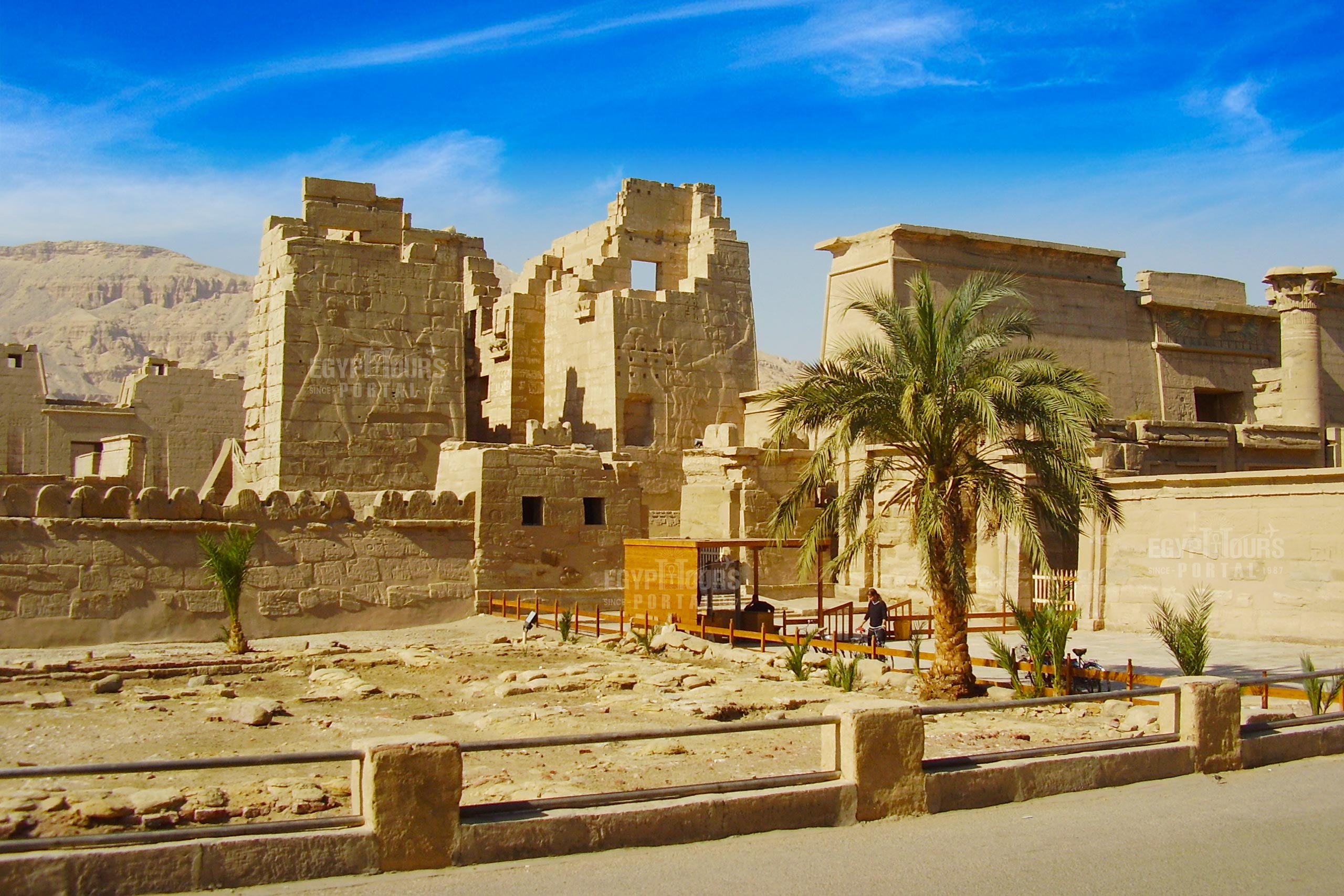
| Overview | |

|
|
| Location | West bank, Luxor. |
| Type | Mortuary temple |
| Period | New Kingdom |
| Purpose | Ramesses III worship |
| Notable Features | Victory reliefs |
| Architecture | Hypostyle halls |
| Significance | Best-preserved |
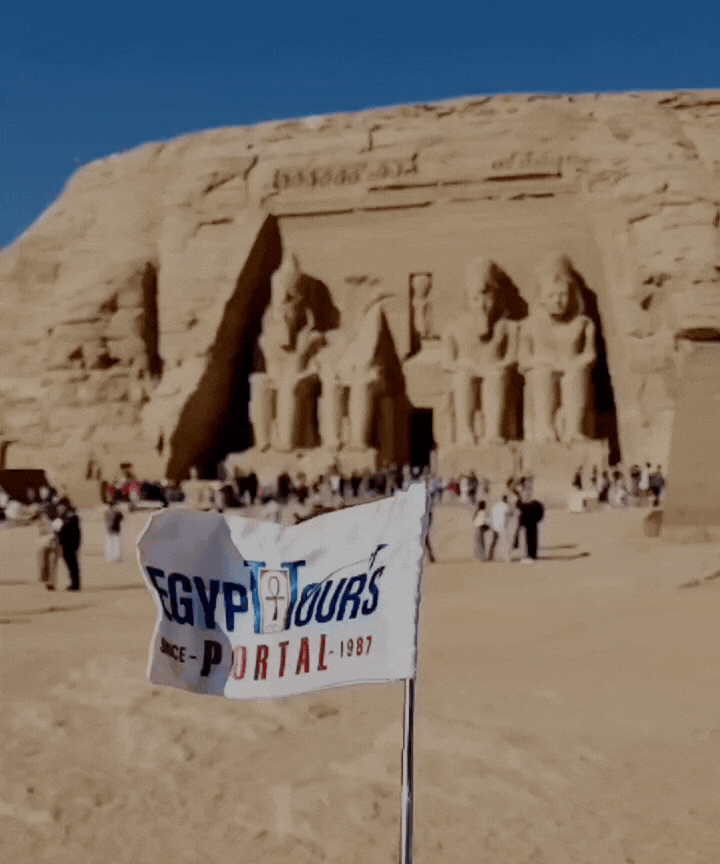
The historical and cultural wealth of Ancient Egypt is infinite, able to take travelers from all over the world on a magical journey through time more than 3500 years ago. It is considered one of the most captivating monuments to explore in the heavenly city of Luxor, famous for its highly preserved carvings, reliefs, and statues.
This ancient mortuary temple of Ramses III was able to stand the test of time and preserve some of the most enchanting collections of artifacts and monuments ever built. This majestic temple holds many great scenes of allure and grandeur worthy of exploring.
Medinet Habu is found in the golden city of Luxor on the west bank of the Nile River in the southern district of the Theban necropolis which is known to be associated with the gigantic and preserved Mortuary Temple of Ramesses III.
In order to reach Medinet Habu, you will simply hire a travel agency that will provide a tour guide and a skilled driver with a private car that showcases the beauty and greatness of this immortal attraction.
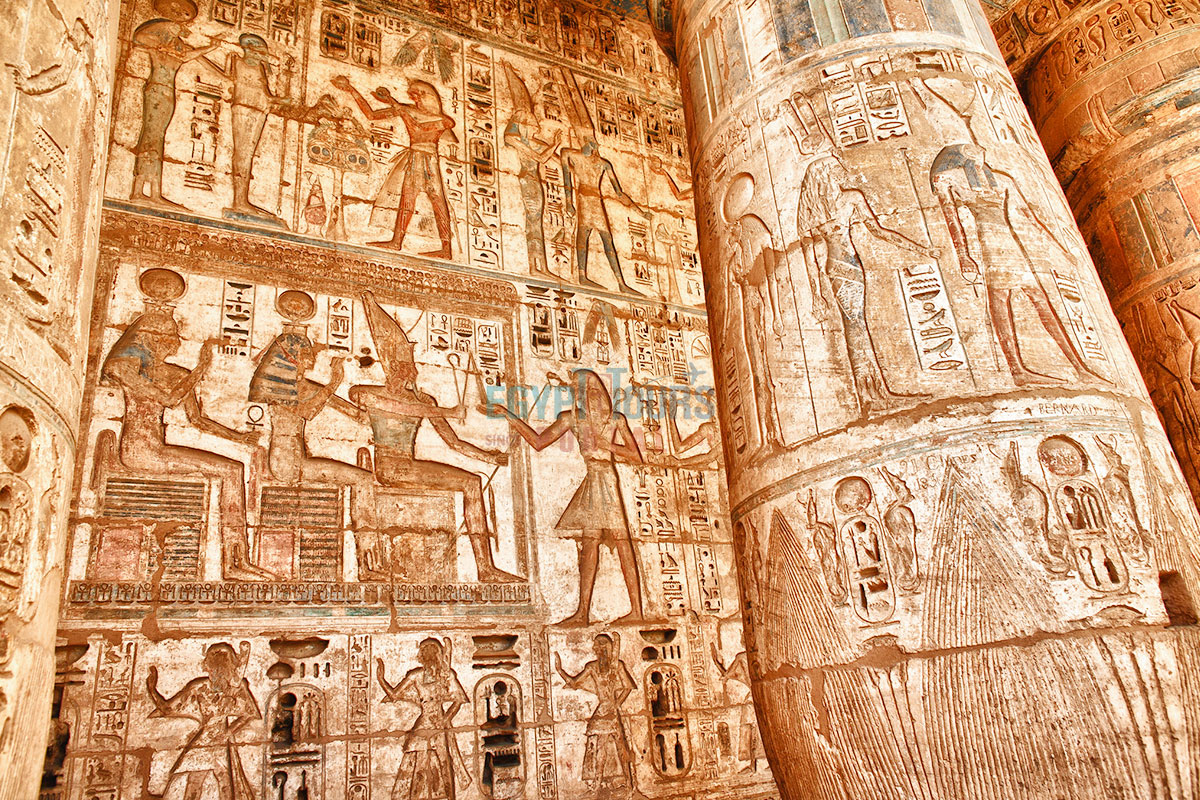
Medinat Habu was built during the New Kingdom (1570 – 1050 BC) by Ramses III (1184 – 1153 BC) the second Pharaoh of the 20th dynasty. Medinet Habu was for centuries the center of the economic life of Thebes. The oldest construction on the site was an Eleven dynasty (2081 – 1938 BC) small shrine that was later enlarged by Thutmose III and Hatshepsut to honor the creator god Amon and the Primeval Ogdoad which is an Eight Deities from the Middle Kingdom.
Step into the awe-inspiring world of the New Kingdom of Ancient Egypt!
Read MoreIt was abandoned in the 3rd intermediate period (1075 – 656 BC) and acted as a private cemetery. The temple held a row of funerary chapels to the so-called wives of Amun during the 20th, 25th, 26th, 29th, and 30th Dynasties plus in the same dynasties and the Greco-Roman were a number of various modifications and alterations.
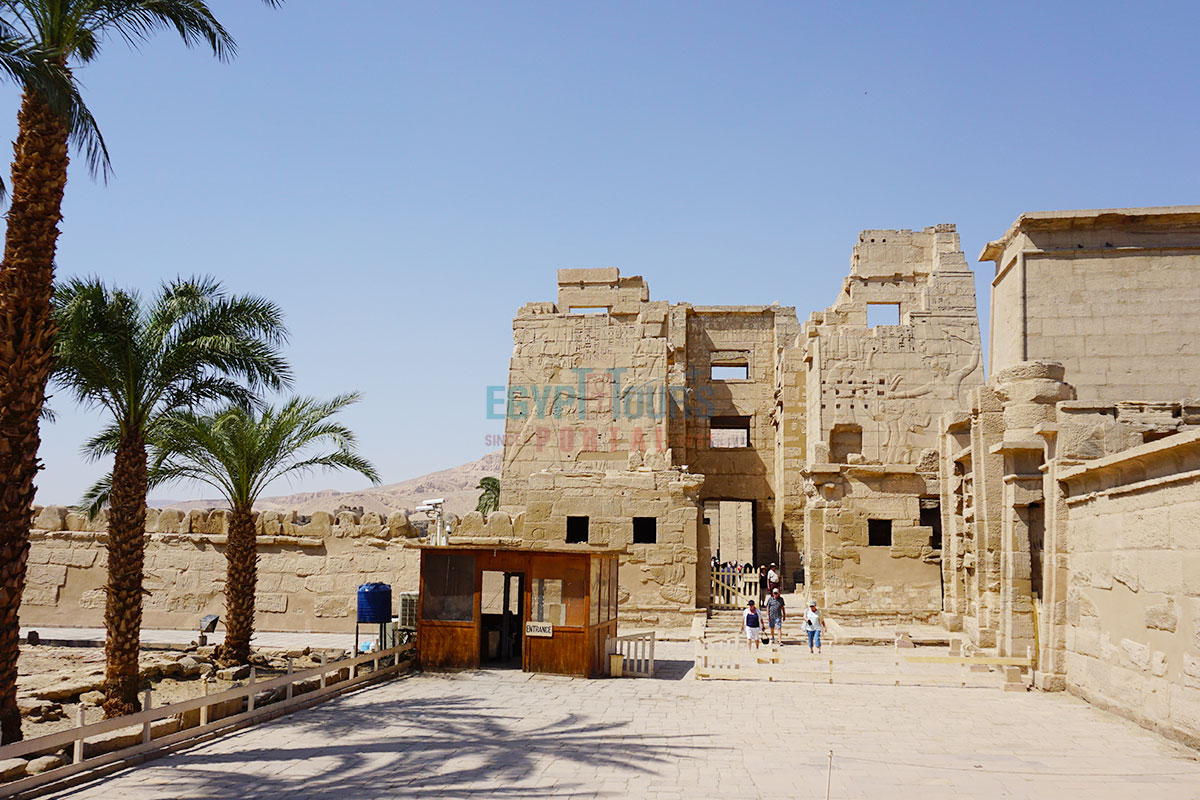
Many may wonder why is the Medinet Habu important and what it was Medinat Habu used the answer is that The archaeological wonder of Medinet Habu is a fortified construction that was a highly important religious center dedicated to the God Amun and a Pharaonic power base within western Egypt.
It was used in times of conflict for protection for the western inhabitants of Thebes and as a center for the Dayr al-Madinah women's village. The complex was also a walled and fortified town for the Coptic Christians in the 9th century AD. It was designed to display military might and celebrate victory in battles against the sea people, Libyans, and Nubians.
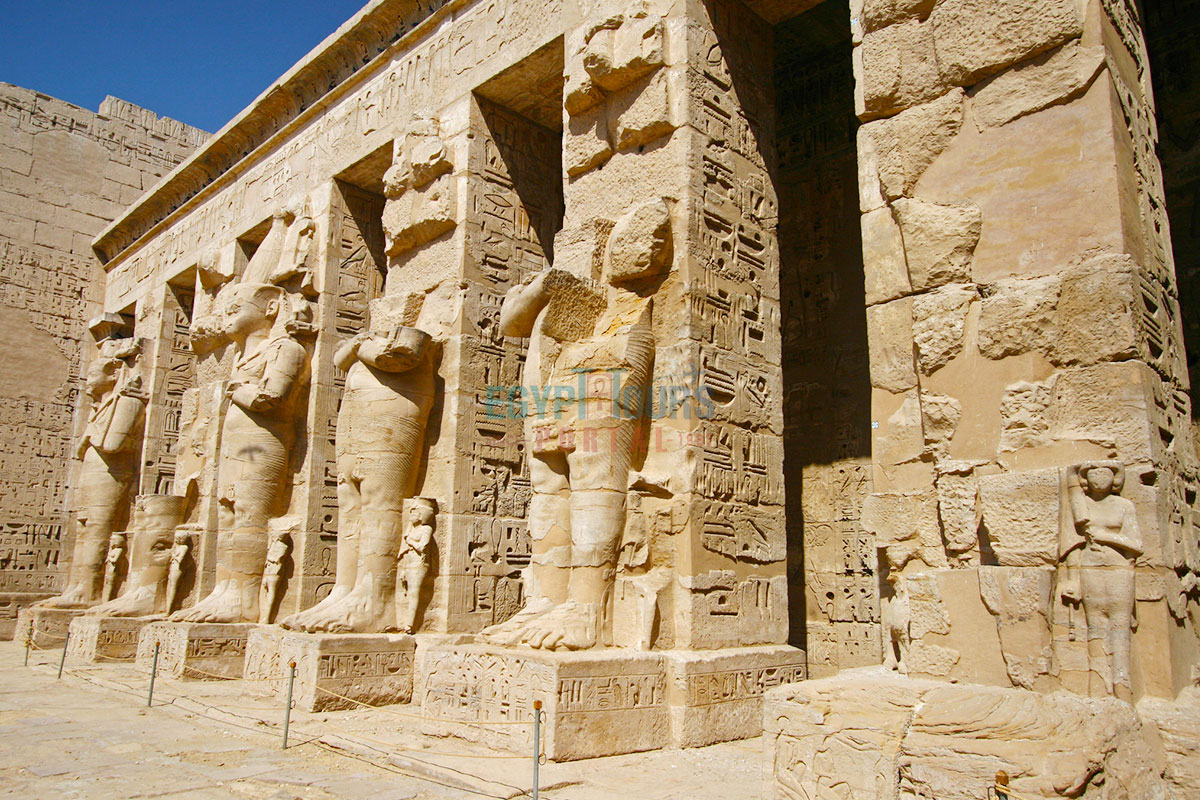
It is the second biggest ancient temple ever constructed on an area of 66,000 square meters on the west bank of the Nile River at the feet of the Theban Hills in the opposite city of Luxor. The Temple measures 200 m in width from the north to the south and 320 m in length from the east to the west.
It is one of the most underrated attractions in Thebes, containing a number of temples, workshops, storage rooms, a royal palace, administrative buildings, and accommodations for officials and priests. It is one of the largest memorial temples in all of Egypt and contains between its gates the temple of Amun, The temple of Ramesses III, and the temple of Ay & Horemheb. It has many courtyards with columns and reliefs that contain the finest and highly intact coloring that leads to a majestic hypostyle hall.
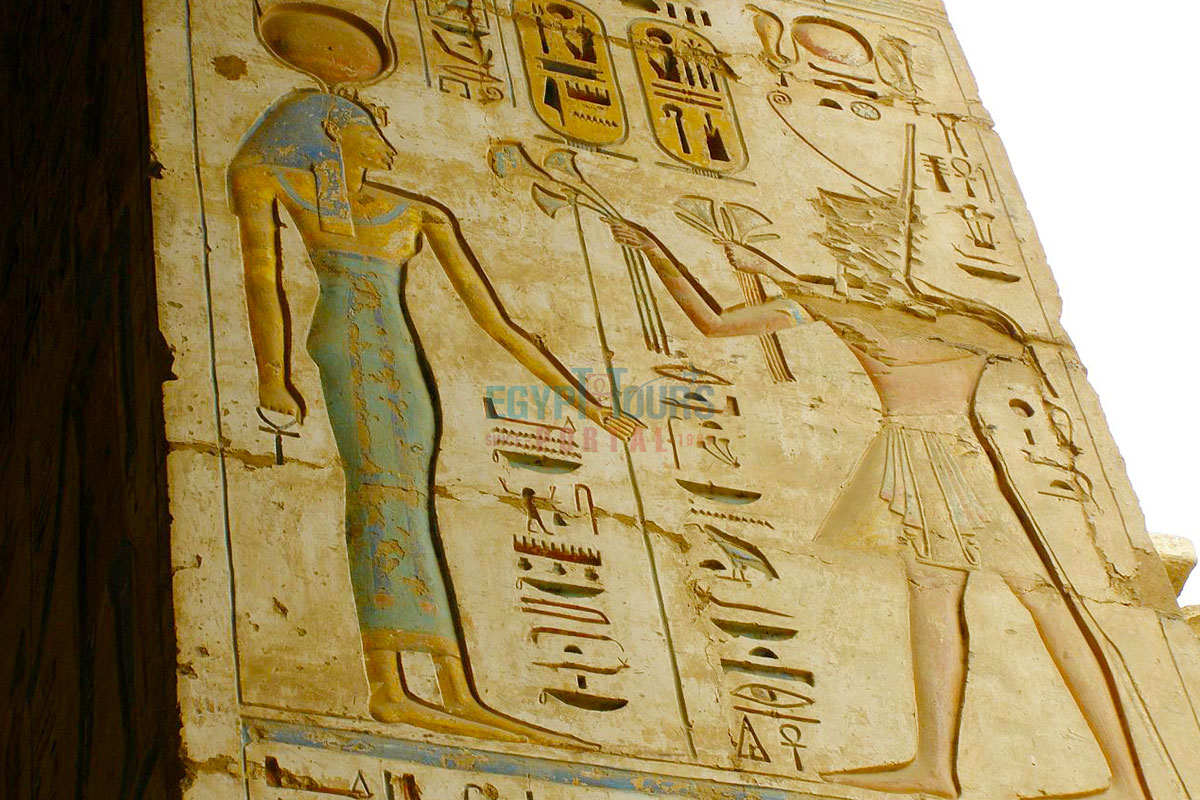
The entire construction is made up of a massive gate in the design of a Syrian fort which is decorated and carved with many battle scenes showcasing Ramsess III's war with the Syrians. Behind the gate is an incredible shrine that dates back all the way to the 18th dynasty. The temple was a wide-open court that led directly to a massive pylon with both of the towers that are decorated with battle scenes such as the king wearing a red crown with the KA, while he is defeating his enemies in the presence of Re-Horakhty and another with the king wearing lower Egypt red crown which smiting his enemies in the presence of Amun-Ra. On the southern tower is an engraved scene of an Oxen Hunt with Ramses II riding his chariot.
The first open court is about 33m wide by 42m long and is decorated with many battle scenes of a war between the Egyptians and the Syrians & Libyans. The second courtyard is about 38m wide by 42m long and holds a small lake it became a basilica in the early Christian era and is filled with scenes of religious ceremonies like the festival and min and Sokar plus other scenes with many holy priests and kings providing offerings to the ancient Egyptian gods.
The first Hypostyle was rocked by an earthquake in 27 BC which once held 24 columns divided into six rows plus surrounded by 16 chapels. Some of the most significant shrines in the temple are the one dedicated to King Ramses III, the second dedicated to Ptah, chapel number four is consecrated for the Sokker Boat, and the seventh chapel dedicated to a sacred boat of Amun-Ra. The chapels on the left side are where the utensils of the temple are stored, chapel number 14 that are dedicated to the divine boat of Pharaoh Ramses II, and Chapel number 15 is dedicated to the sacred boat of Montho. The 2nd hypostyle hall contains eight papyrus columns in two rows while the ceiling is supported by eight columns in two rows. The Hypostyle hall has an end that possesses three entrances the entrance in the center leads to the sanctuary that is dedicated to the Theban triad where the Amun-Ra sacred boat is found, the chapel of god Khonsu on the left side leads to the chapel of Mut.

The magnificent Temple of Ramesses III is found in the incredible ancient structure of Medinet habu that was built in the new kingdom (1570 – 1050 BC) on the west bank of Luxor. The site is recognized for its amazing architectural significance plus its epic size. This phenomenal structure has a number of legendary inscribed reliefs showcasing the defeat of the great sea people during the reign of Ramesses III. The temple is 150 m long and has a design similar to the close mortuary temple of Ramesses II. The entrance of the temple is through a powerful stronghold gatehouse. The temple is filled with highly preserved walls surrounded by a substantial fortified mudbrick enclosure. Within the enclosure are a number of chapels dedicated to the Divine Adoratrices of Amun. The colossal temple contains colossal statues of Ramesses III, peristyle halls, courtyards, and a large hypostyle hall.
There are many decorations and reliefs found on the walls which symbolize the Pharaoh’s control over regions like Nubia and Syria. In the Coptic age, a church and Christian carvings were added to the temple’s walls. Its greatest possession includes the list of Medinet Habu King on the eastern wall in the second courtyard, which hold celebrations of 9 pharaohs and document plus celebrates the festival of min. The temple was detailed around 1829 by Jean-François Champollion. Between the years of 1859 and 1899, many excavations took place where a number of Greco-Roman structures plus a Byzantine church were destroyed. Around 2014, many excavations were done by the University of Chicago Oriental Institute.
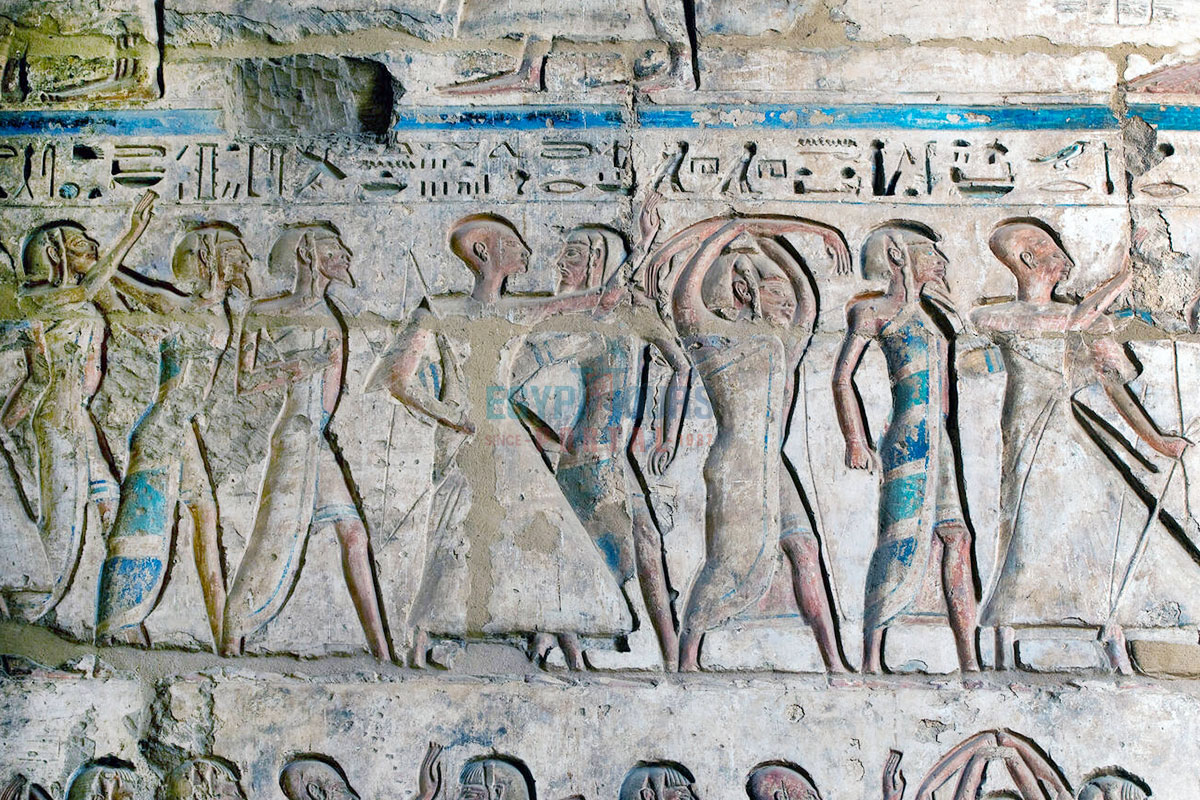
Medinet Habu is a true piece of magic and art with a great wealth of knowledge as all the reliefs and inscriptions are able to showcase a number of different historical events a group of seafaring warriors known as the sea people who were confederacy made of naval raiders who attacked many coastal towns and cities in the Mediterranean area between 1276-1178 BCE which led to the collapse of the late bronze age. There were many focused on attacking Egypt which explains why most of the information on them is from Egyptian sources.
Uncover the untold stories and historical significance of the Battle of Djahy!
Read MoreThe records show the victories of three great Pharaohs, Ramesses II (1279-1213 BCE), his son and successor Merenptah (1213-1203 BCE), and Ramesses III (1186-1155 BCE) over the sea people at the battle of Djahy. For over a century, they were seen as a constant challenge to the prosperity of Egypt. All these facts are mentioned on Medinet Habu displaying valuable historical information about these events.
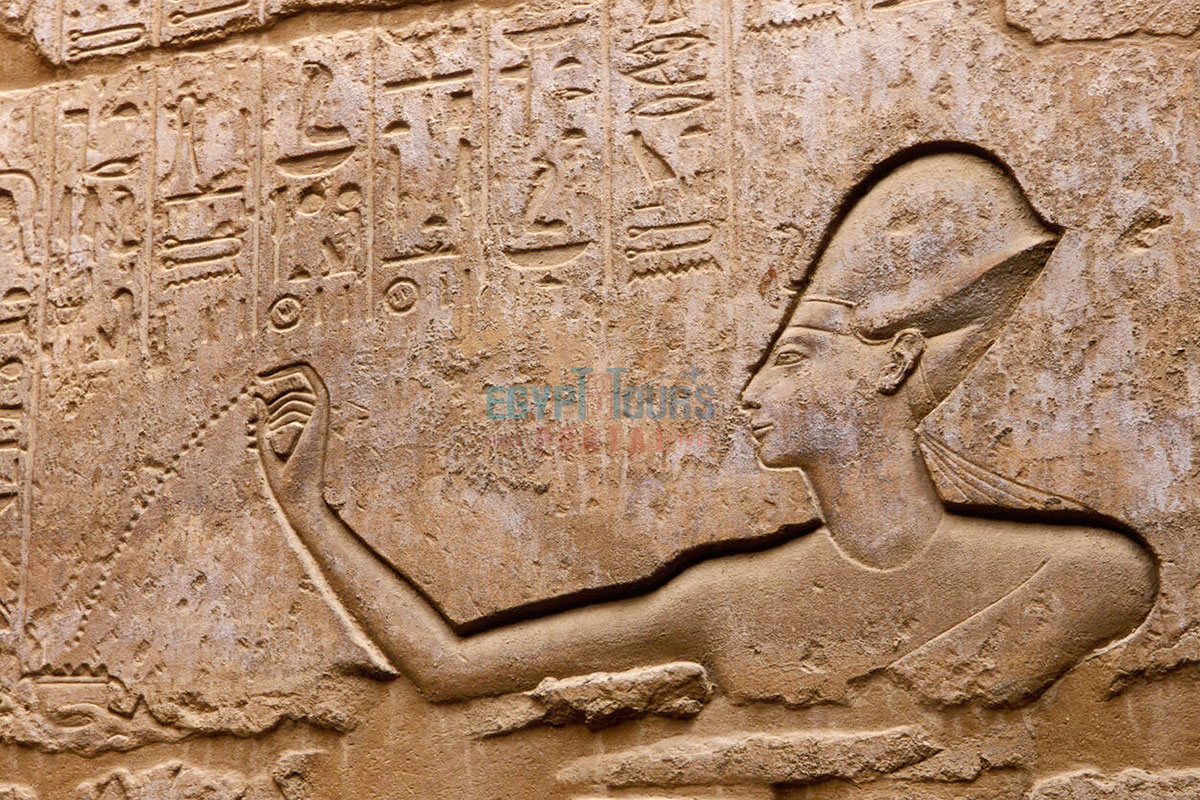
All the inscriptions and reliefs of Medinet Habu contain many majestic scenes of daily life, military campaigns, and religious ceremonies. The reliefs and inscriptions at Medinet Habu provide a wealth of facts and information about ancient Egyptian history, art, and culture showcasing the life and reign of Ramesses III and the religious practices of the time. One of the most important displays includes the depiction of the battle of the Delta where Ramses III defeated the sea People.
There are a number of religious scenes showcasing the king's titulary, dedicatory inscriptions, offerings, and prayers to the gods, displaying all the devotion of the ancient Egyptian society. The entire complex is a living museum filled with a number of detailed artwork and hieratic graffiti. All these reliefs & inscriptions have been the subject of the excavation of skilled Egyptologists and archaeologists who attempted to understand the events and religious practices of the New Kingdom period in ancient Egypt.
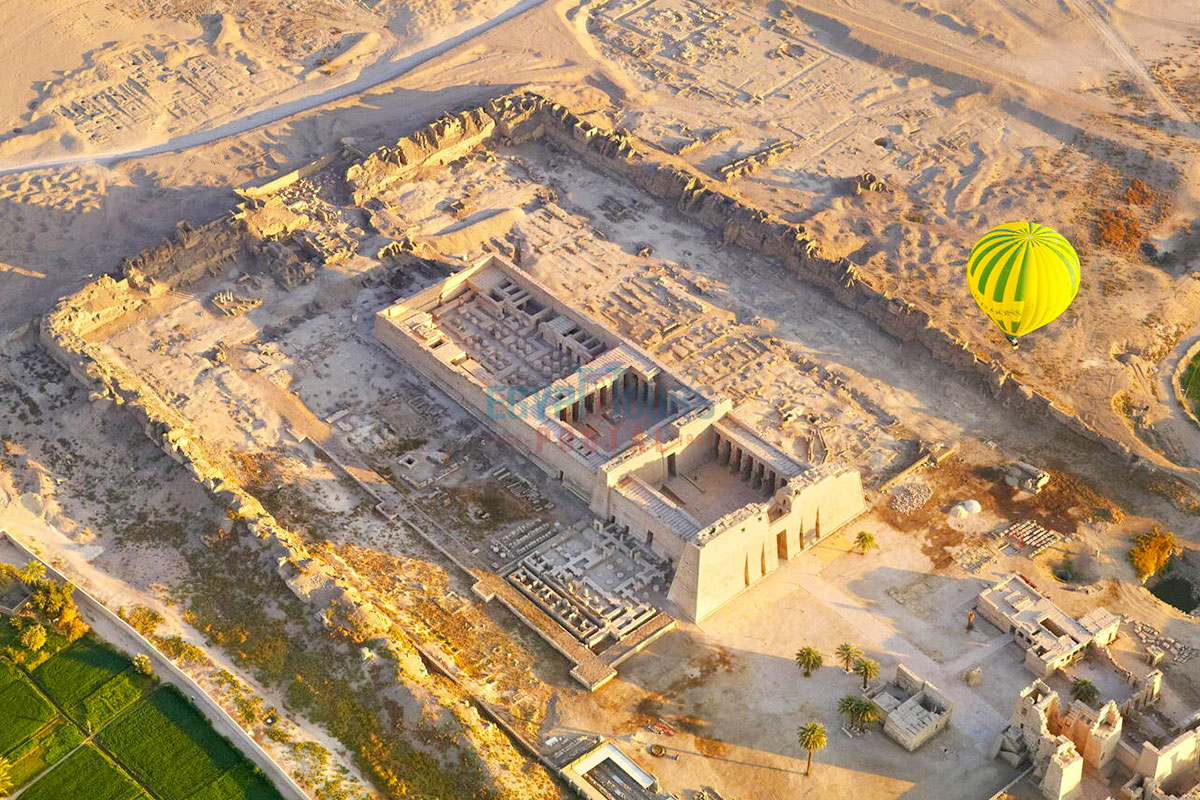
The land of Thebes is the world’s greatest open-air museum filled with the finest examples of ancient architecture showcasing the greatest monuments ever created in the history of mankind, offering a gate to the legendary history of the New Kingdom. Luxor tours allow visitors to explore the ancient city of Luxor in Egypt. Don't miss out on the opportunity to explore the rich history and culture of Luxor. Book your tour today and experience the wonders of the ancient city for yourself!"
Day Trip from Luxor to Cairo by Plane For Australian Travelers Day trip from Luxor t...
Tour Location: Cairo...
Tour to Luxor West Bank For Australian Travelers Tour to Luxor West Bank is like ste...
Tour Location: Luxor...
Tour to Edfu and Kom Ombo For Australian Travelers Edfu & Kom Ombo tour fro...
Tour Location: Edfu/Kom Ombo...
Trip to Dandara and Abydos from Luxor for Australian Travelers A Trip to Dandara and...
Tour Location: Dandara/Abydos...
The height of the complex of Medinet habu can vary due to the different number of columns and walls that come in various sizes and many shapes that carry intricate reliefs and hieroglyphs. All the structures were constructed in the typical architectural style of ancient Egyptian temples, characterized by towering pylons, courtyards, and hypostyle halls.
All the structures were constructed in the typical architectural style of ancient Egyptian temples, characterized by towering pylons, courtyards, and hypostyle halls. The design of Medinet Habu is similar to that of the Mortuary Temple of Ramesses III.
The significance of Medinet Habu is one of the most preserved examples of ancient Egyptian complex architecture from the New Kingdom that contain a wide variety of art that sheds light on historical and religious information like military campaigns, pharaonic rituals, and daily life in ancient Egypt plus the reign of Ramesses III.
This UNESCO World Heritage Site is definitely worth visiting for anyone interested in ancient Egyptian history, architecture, and art of the new kingdom during the Ramesside era. The site's archaeological significance and its connection to the Sea Peoples and Ramesses III make it an important stop for travel and history enthusiasts.
The entire country of Egypt deserve to be explored with its every heavenly detail but there are places that must be seen before any other such as the breathtaking Hurghada's red sea, The wonders of Cairo the pyramids of Giza, the great sphinx, the Egyptian Museum, Khan El Khalili Bazaar, the wonders of Luxor like Valley of the Kings, Karnak & Hatshepsut temple and the wonders of Aswan such as Abu Simbel temples, Philea temple, Unfinished obelisk and The Wonders of Alexandria like Qaitbat Citadel, Pompey's Pillar and Alexandria Library. Read more about the best places to visit in Egypt.
If you want to apply for a Visa On Arrival that lasts for 30 days then you should be one of the eligible countries, have a valid passport with at least 6 months remaining and pay 25$ USD in cash, as for the E-Visa for 30 day you should have a valid passport for at least 8 months, complete the online application, pay the e-visa fee then print the e-visa to later be presented to the airport border guard. You could also be one of the lucky ones who can obtain a free visa for 90 days. Read more about Egypt travel visa.
Egypt has a variety of delicious cuisines but we recommend “Ful & Ta’meya (Fava Beans and Falafel)”, Mulukhiya, “Koshary”, a traditional Egyptian pasta dish, and Kebab & Kofta, the Egyptian traditional meat dish.
The best time to travel to Egypt is during the winter from September to April as the climate becomes a little tropical accompanied by a magical atmosphere of warm weather with a winter breeze. You will be notified in the week of your trip if the Climate is unsafe and if any changes have been made.
You should pack everything you could ever need in a small bag so you could move easily between your destinations.
We have been creating the finest vacations for more than 20 years around the most majestic destinations in Egypt. Our staff consists of the best operators, guides and drivers who dedicate all of their time & effort to make you have the perfect vacation. All of our tours are customized by Travel, Financial & Time consultants to fit your every possible need during your vacation. It doesn't go without saying that your safety and comfort are our main priority and all of our resources will be directed to provide the finest atmosphere until you return home.
You will feel safe in Egypt as the current atmosphere of the country is quite peaceful after the government took powerful measures like restructuring the entire tourist police to include all the important and tourist attractions in Egypt. Read more about is it safe to travel to Egypt.
Wear whatever feels right and comfortable. It is advised to wear something light and comfortable footwear like a closed-toe shoe to sustain the terrain of Egypt. Put on sun block during your time in Egypt in the summer to protect yourself from the sun.
The best activity is by far boarding a Nile Cruise between Luxor and Aswan or Vise Versa. Witness the beauty of Egypt from a hot balloon or a plane and try all the delicious Egyptian cuisines and drinks plus shopping in old Cairo. Explore the allure and wonders of the red sea in the magical city resorts of Egypt like Hurghada and many more by diving and snorkeling in the marine life or Hurghada. Behold the mesmerizing western desert by a safari trip under the heavenly Egyptian skies.
There are a lot of public holidays in Egypt too many to count either religious or nation, the most important festivals are the holy month of Ramadan which ends with Eid Al Fitr, Christmas and new years eve. Read more about festivals & publich holidays in Egypt.
Egypt is considered to be one of the most liberal Islamic countries but it has become a little bit conservative in the last couple of decades so it is advised to avoid showing your chest, shoulders or legs below the knees.
Arabic is the official language and Most Egyptians, who live in the cities, speak or understand English or at least some English words or phrases. Fewer Egyptians can speak French, Italian, Spanish, and German. Professional tour guides, who work in the tourism sector, are equipped to handle visitors who cannot speak Arabic and they will speak enough English and other languages to fulfill the needs of all our clients.
The fastest way is a car, of course, a taxi. If you are in Cairo ride a white taxi to move faster or you could board the fastest way of transportation in Egypt metro if the roads are in rush hour.
The temperature in Egypt ranges from 37c to 14 c. Summer in Egypt is somehow hot but sometimes it becomes cold at night and winter is cool and mild. The average of low temperatures vary from 9.5 °C in the wintertime to 23 °C in the summertime and the average high temperatures vary from 17 °C in the wintertime to 32 °C in the summertime. The temperature is moderate all along the coasts.
It is the home of everything a traveler might be looking for from amazing historical sites dating to more than 4000 years to enchanting city resorts & beaches. You will live the vacation you deserve as Egypt has everything you could possibly imagine.









